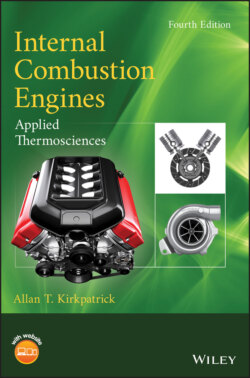Читать книгу Internal Combustion Engines - Allan T. Kirkpatrick - Страница 58
Four‐Stroke Otto Gas Cycle Analysis
ОглавлениеWhen we include the exhaust and intake strokes, we have two additional equations for the gas cycle analysis, the exhaust energy equation and the intake energy equation. The two unknown parameters in these equations are the residual gas fraction, , and the gas temperature at the end of the intake stroke, . When the residual gas fraction is taken into account, the energy addition, , is
(2.68)
where is the energy addition per unit mass of gas inducted.
The cycle input parameters in this four‐stroke gas cycle analysis are summarized in Table 2.2. Since it is difficult to solve these two equations algebraically, the solution is found by iteration, as shown in this section. Since is dependent on the residual gas fraction, , and the residual gas temperature, , we first need to estimate the values of and , then iterate through the cycle calculation repeatedly to get converged values of and .
Table 2.2 Input Parameters for Four‐Stroke Gas Cycle
| Parameter | Description |
| inlet air or mixture temperature | |
| compression ratio | |
| exhaust pressure | |
| inlet pressure | |
| ideal gas specific heat ratio | |
| energy addition per unit mass of gas induced |
6, i ‐1: Intake stroke
1‐2: Isentropic compression stroke
2‐3: Constant volume heat addition
3‐4: Isentropic expansion stroke
4‐5: Isentropic blowdown
5‐6: Constant pressure adiabatic exhaust stroke
Appendix F contains a listing of the program FourStrokeOtto.m, which iterates through the above four‐stroke Otto gas cycle equations to determine the cycle pressures, temperatures, and the overall thermal parameters.
